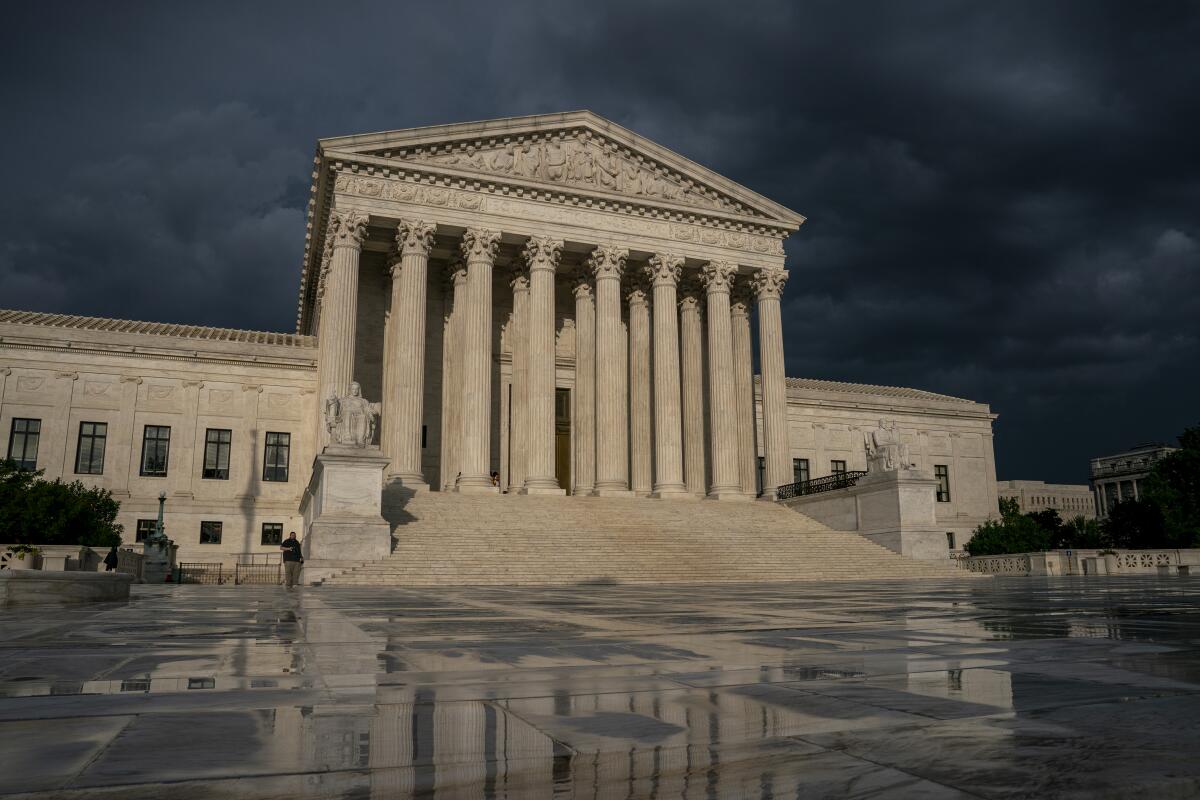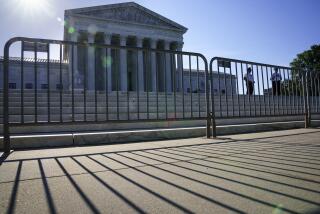Op-Ed: What do we teach law students when we have no faith in the Supreme Court?

- Share via
At the start of this new semester, we face a sobering reality. As law and political science professors, we’re in new territory: instructing our students about the foundations of constitutional law when neither they nor we have faith that the current Supreme Court will respect precedent and approach the law as the institution once had.
It is now clear that the court, with six conservatives — three appointed by Donald Trump — has a different attitude toward interpreting the Constitution and preserving fundamental rights.
Students see a court about to overrule or gut Roe vs. Wade, a half-century-old precedent, for no reason other than that the conservatives have the votes to do so. They see a majority of the justices eager to advance Republican ideology in blocking vaccine or testing requirements for large businesses. They see the conservative majority mandating government aid to religious schools and greatly expanding gun rights, even when it means departing from decades of prior decisions. They see a court where major rulings are issued without briefing and oral arguments on a “shadow docket,” including 5-4 decisions limiting the power of governors to impose restrictions on religious gatherings to stop the spread of COVID.
Today’s students aren’t alone in losing faith in the Supreme Court. A recent Gallup Poll showed the institution at its lowest level of public confidence in decades: Only 40% of Americans approve of the job it is doing and 53% disapprove. There is every reason to think that this is going to get worse and soon. Although two-thirds of the public believe Roe should not be overturned, the court seems poised to do just that this year, further damaging its credibility with a large segment of the public, though it will please the Republican Party’s base.
So what should we tell our students? Many are dispirited and cynical because, as far into the future as they can see, this court appears likely to do more harm than good to democracy.
First, we shouldn’t hide the reality that judicial decisions often depend on who is on the bench. That has never been more true because the entrenched partisan Senate confirmation process now guarantees that a Supreme Court nominee will be chosen to carry out political and ideological aims. For the first time in American history, the ideology of the justices precisely corresponds to the political party of the president who appointed them. All six conservatives were appointed by Republican presidents and all three liberals were appointed by Democratic presidents.
Until recently, there were moderate liberals, such as John Paul Stevens and David H. Souter, appointed by Republicans, and there were moderate conservatives, such as Byron White and Felix Frankfurter, who had been appointed by Democrats. Trump picked three of the most ideologically conservative judges on the federal bench.
If students are to one day become effective litigators on constitutional rights, they will need to understand the ideologies of the justices interpreting the law. In the past, we certainly discussed the ideology of the justices with our students, but we must focus on it far more now as the ideological differences between the Republican-appointed justices and judges and those appointed by Democratic presidents are greater than they have ever been.
Second, we must remind students that there have been other bleak times in constitutional law when rights were contracted. From the 1890s until 1936, a conservative Supreme Court struck down over 200 progressive federal, state and local laws protecting workers and consumers. In the late 1940s and early 1950s, the court refused to stand up to the hysteria of McCarthyism. The current court will not last forever, though it may feel like that to them.
Third, we should direct focus on other avenues for change. Students need to look more to state courts and legislatures, at least in some parts of the country, as a way to advance liberty and equality. For instance, the Massachusetts Legislature passed a law known as the “Roe Act,” protecting a woman’s right to abortion under state law, no matter what the Supreme Court decides. We need to teach our students how to use the power of local governments to protect fair housing, public education and public health.
Fourth, we must encourage them to look at the sweep of history. In the early 1960s, almost half the states had Jim Crow segregation laws, there were few women going to law school, and every state had a law criminally prohibiting same-sex sexual activity. The Rev. Martin Luther King Jr. was right when he said that the arc of the moral universe is long and it bends toward justice — if we work for it.
There really are just two choices: Give up or fight harder, even if there will be a lot of losses along the way. If we can instill in students a desire to defend justice, even if victory is distant, it will be a good semester, no matter what the Supreme Court decides.
Erwin Chemerinsky is dean of the UC Berkeley School of Law and a contributing writer to Opinion. Jeffrey Abramson is professor of law and government at the University of Texas at Austin.
More to Read
A cure for the common opinion
Get thought-provoking perspectives with our weekly newsletter.
You may occasionally receive promotional content from the Los Angeles Times.










